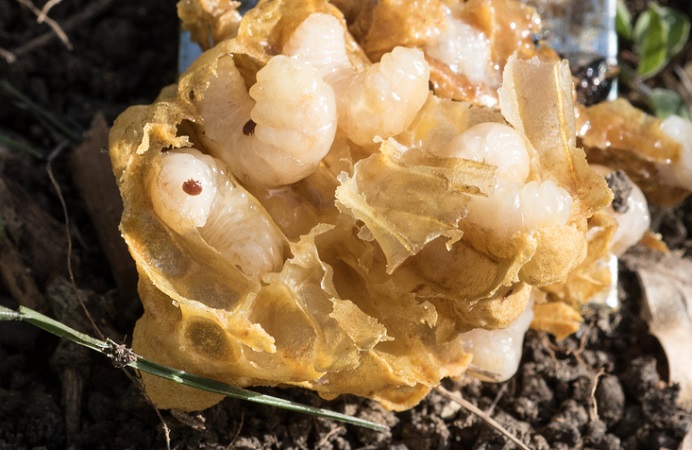

Honey bees currently face three difficult challenges to their survival, a lack of quality nutrition, ubiquitous pesticides in the environment, and the scourge of the varroa mite. Beekeepers can have some positive impact on the lack of nutrition by planting bee-friendly flowers and encouraging others to do the same. We can also reduce or eliminate our own use of chemicals in our environment and educate friends and family to do the same as well. The greatest opportunity for impact, in my humble opinion, comes in the form of varroa mite management in our bee hives.
Varroa Mite Life Cycle
Varroa destructor (its scientific name) are tiny arachnids that evolved alongside the Asian honey bee. At some point, it “jumped” to the European honey bee with devastating consequences. Among the pests found in beehives (such as mice, ants, wax moths, and hive beetles) varroa mites are, in my opinion, the worst.
There are female and male mites. The female is significantly larger than the male though neither get much bigger than the head of a pin. Males are typically white while females are red.
Varroa exist in two stages — phoretic and reproductive. During the phoretic stage, the female mite feeds on adult bees for between five to 11 days during brood rearing times. When there is no brood present, mites remain in the phoretic stage semi-permanently. As they tend to prefer the ventral (belly) side of bees, phoretic mites often avoid visual detection by the beekeeper. From time to time, the beekeeper may see a phoretic mite on the dorsal (back) side of a bee, though the general rule of thumb is, “If you see mites, you have too many!”
The reproductive stage occurs entirely under capped brood. Just before a bee larva is capped, a female, phoretic varroa mite sneaks into the cell and hides beneath the larva. After the bees cap this cell, the mite attaches itself to the larva/pupa and begins to feed on it. About three days later, the female mite will start laying eggs. The first egg she lays is unfertilized and will become a male. Every egg thereafter, laid approximately 30 hours apart, will be fertilized and destined to become female mites. As the daughter mites emerge they will mate with the son mite and slowly mature to adult form. When the bee pupa becomes an adult bee and emerges from the cell, the original mother mite and any mature daughter mites will emerge as well and continue their life cycle.
Varroa mites prefer honey bee drone brood to reproduce. As drone brood take roughly three days longer than workers to mature and emerge, it provides the mites an opportunity to lay more eggs and have more daughters mature. In fact, in drone brood, mites can produce between two to three times more mature adult daughters than in worker brood.
If left untouched (by treatment or bees biting them off) in the colony, mites can live for weeks or even months.
How Does the Varroa Mite Kill the Colony?
The honey bee is ill-equipped to meet the challenge varroa mites present. Mites decimate honey bee colonies in two ways — slow weakening and transmission of viruses.
Recent research suggests the varroa mite feeds off the fat bodies of the honey bee. This has at least three significant negative impacts on the bee. First, during the reproductive stage the mother, son, and daughter mites feed off the bee pupa they are growing alongside it. This weakens the pupa during its most critical growth phase resulting in a “less than healthy” adult bee. Over time, this has a negative impact on the entire colony as the mite population grows.
Second, during the phoretic stage, the mites are feeding off adult bees and slowly them. As these are the bees charged with caring for the hive from brood rearing to foraging for resources, one can imagine how this has a cumulative negative effect on the colony.
Lastly, the bees’ fat bodies are a critical physiological component to cold weather survival. The mite population grows alongside the bee population. In late dry season, the bees begin slowing down brood rearing and reduce the size of the colony. The mites, however, continue reproducing.
All the above would be bad enough but the mites don’t stop there — they also transmit several viruses to the bees. One virus, deformed wing virus (DWV), is common in bee hives with high mite populations. DMV results in bees with unformed or deformed wings leaving them unable to fly. They are otherwise fully functional so they move through the stages of life within the hive like most other bees. However, when it comes time to leave the hive and fly, they fall to the ground, crawl off, and perish. Unable to become foragers, they must be replaced by another bee within the colony. This constant “changing of duties” means fewer and fewer bees inside the hive caring for brood, building comb, defending the hive, or other important duties. Eventually, the colony collapses.
 Contact Jaguza Support
Contact Jaguza Support